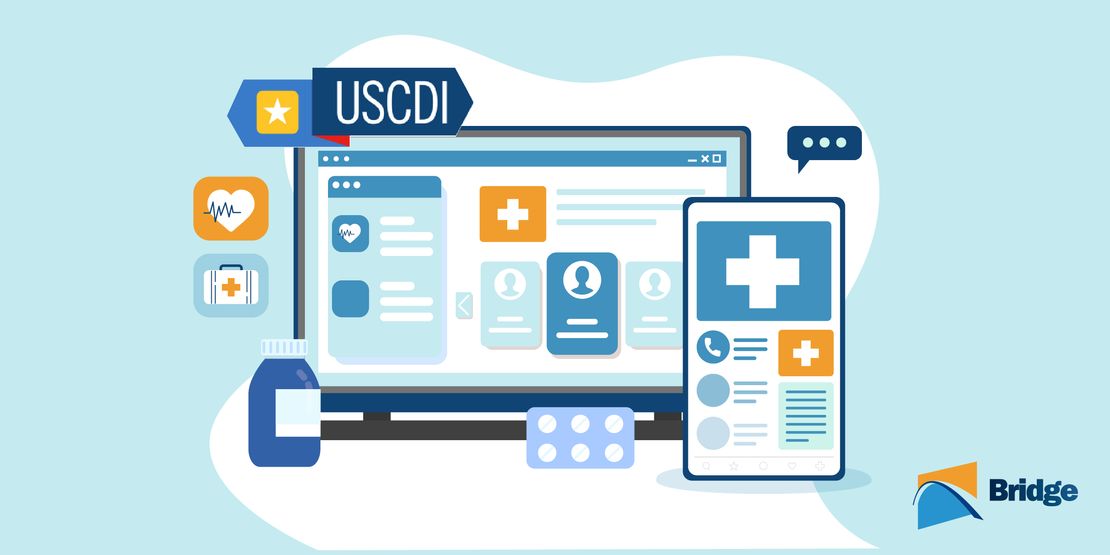What Is USCDI?
- The Bridge Team
- April 25, 2023

Electronic health information has become critical to the operation of the modern healthcare system, especially as it pertains to patient engagement tools. According to HealthIT.gov, nearly 4 in 5 office-based physicians (78%) and nearly all non-federal acute care hospitals (96%) had adopted a certified electronic health record (EHR) system by 2021. (1) But what kind of health information should be recorded, exactly? And how?
Effective care of a patient population requires sharing knowledge between healthcare institutions due to traveling patients, research collaborations, transferring staff, and a host of other reasons. Likewise, patients should have an idea of what to expect when they use their patient portal or mhealth app. Ideally, there should be a common standard of data collection and storage to facilitate this exchange of information.
Enter the USCDI (United States Core Data for Interoperability) standard. USCDI was created by the Office of the National Coordinator for Health Information Technology (ONC) as a framework for coordination between different institutions that use electronic health information.
USCDI is a standardized set of data elements that should be recorded and included in a healthcare provider’s EHR. It includes things like:
- Patient details (e.g., name, address, ethnicity, contact information, etc.)
- Laboratory tests and results
- Clinical notes
- Health concerns
- Allergies and intolerances
- Immunizations
- Vital signs
- Smoking status
- Implanted devices
You can view the full set of elements included in USCDI’s current version here. (2)
USCDI Terminology
When looking at the USCDI categories, you can see that the data points are classified in a hierarchical structure.
- Data elements are the most granular unit of information (e.g., a patient’s date of birth)
- Data classes are a grouping of related data elements; for example, a patient’s date of birth (element) forms part of patient demographics (class)
- Levels denote how important the information is, including level 2 (most important), level 1 (less important), and comment (least important).
Why Is the Cures Act Important?
USCDI was developed by ONC along with the 21st Century Cures Act. The Cures Act covers a wide range of healthcare mandates, but the issue of interoperability is especially relevant to its Anti-Information Blocking Rule, which requires sharing electronic health information via API without delay. (3) USCDI was developed to define for healthcare developers exactly what counts as electronic health information.
What Is USCDI For?
This set of standards lays out the categories and data formats different healthcare technology tools and APIs should be able to support. All certified EHR systems in the U.S. are required to share data as outlined by the USCDI. It is also the reference used by regulatory agencies when auditing a healthcare provider to investigate whether they are blocking information.
The aim of USCDI as defined by the ONC is “to comprise a core set of structured and unstructured data used to support patient care and facilitate patient access via health IT tools.”
It is also intended to serve as a baseline of harmonized data elements that can be reused in other healthcare cases and inform the design of healthcare technology platforms.
USCDI is designed to align and stay compatible with existing HL7 API standards such as FHIR, making it easier for healthcare tech developers to create interoperable systems.
Ongoing Development of USCDI
USCDI is not static; rather, it is designed to be expanded over time via an open collaborative process. This process includes input from healthcare stakeholders such as clinics, hospitals, academic departments, nonprofits, trade associations, and more. New technological standards, industry performance, feasibility, and user feedback are all taken into account.
The current version of USCDI is v3, with a draft version of v4 already available. You can still make recommendations for elements and classes to be considered for USCDI v5.
How Does USCDI Apply To Patient Portals?
Patient portals are just one type of healthcare tech tool that must be designed to support the USCDI standard. Failure to do so can lead to lost information, a negative user experience, and even legal consequences (e.g., information blocking under the Cures Act). On the other hand, its increasing familiarity among users of healthcare IT makes it an ideal framework for patients or healthcare workers sorting through a potentially very dense database to find exactly what they want.
For example, Bridge Patient Portal’s APIs access EHR and provide the information to users. Users who query data will be able to search for and filter for USCDI elements quickly and easily. To achieve this, Bridge’s API experts designed Bridge Patient Portal to integrate disparate EHR systems and formats to be viewable and searchable according to USCDI and HL7 frameworks. As a result, the portal is user-friendly and compliant with healthcare regulations governing EHI, such as HIPAA for privacy and security or the Cures Act’s information-blocking rules. For more information, contact us to schedule a consultation or request a demo.
Resources:
- Official Website of The Office of the National Coordinator for Health Information Technology (ONC). Quick Stats. Link. Accessed March 6, 2023.
- Official Website of The Office of the National Coordinator for Health Information Technology (ONC). United States Core Data Interoperability. Link. Accessed March 6, 2023.
- Federal Register. 21st Century Cures Act: Interoperability, Information Blocking, and the ONC Health IT Certification Program. Link. Accessed March 6, 2023.